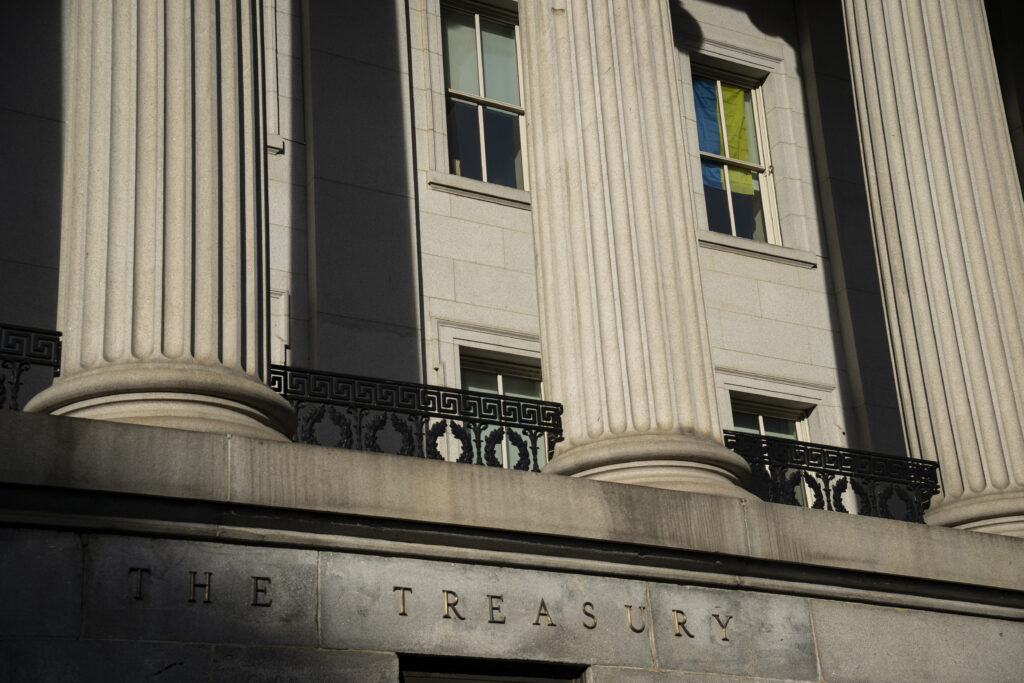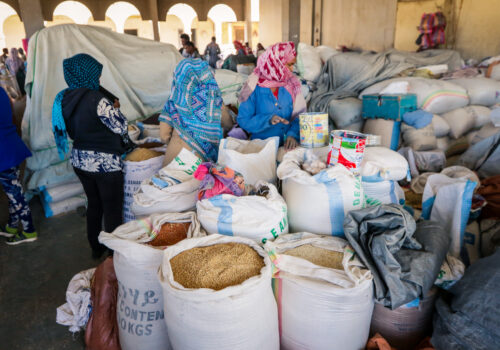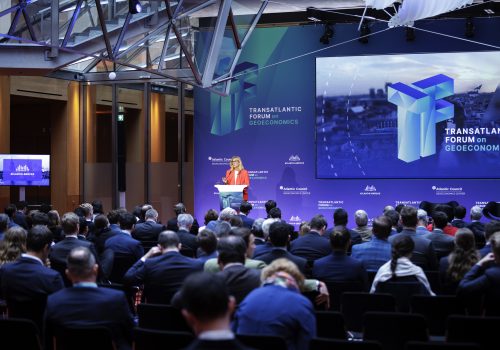Dating back to at least ancient Greece, great powers have deployed economic tools to advance foreign policy objectives. Today, the frequency and potency with which governments deploy “economic statecraft”—which includes sanctions, export controls, tariffs, investment restrictions, and price caps, among other tools—has never been higher.
This trend reflects both opportunity and necessity. The era of hyperglobalization is over, but the world economy remains more connected than ever, providing nations the opportunity to break linkages of trade, capital, and technology (or threaten to do so) for geopolitical advantage. At the same time, we have entered the most intense period of great power competition since the Cold War ended, with Russia and China expressing a shared desire to upend the US-led international order. Since today’s “great powers” are also nuclear powers, barring catastrophic miscalculation, the logic of mutually assured destruction suggests that direct confrontation is more likely to play out in the theater of economics than on the battlefield.
The implication is that economic statecraft will remain a fixture of foreign policy—filling the policy space between war and words when conflicts emerge. But for economic statecraft to have maximum effect, it should be grounded in a doctrine that animates the United States’ guiding purpose to enhance global prosperity while safeguarding national security. Indeed, while the United States has spent hundreds of years developing and refining its doctrine for military engagement—for example, by identifying “containment” as the strategic anchor at the dawn of the Cold War—the effort to formulate a grand strategy for economic statecraft has only recently begun.
A doctrine of economic statecraft
Laying down a doctrine would serve multiple objectives. If taken seriously, it would limit overreach in the use of restrictive or punitive forms of statecraft. It might also reassure other countries that the world’s leading economic power is not firing economic weapons in an arbitrary or reflexive manner. Most profoundly, it could promote balance in the conduct of statecraft—specifically, between measures that impose economic pain and those that offer the prospect of mutual economic gain—and in doing so, enhance the credibility of economic statecraft and help to bring geopolitical “swing states” into strategic alignment.
Recent events underscore the urgency of this effort. Two years after the start of Russia’s full-scale invasion in Ukraine, more than two-thirds of the world’s population lives in countries that have not joined the sanctions coalition. Some officials from nonaligned countries have voiced concerns about the efficacy of sanctions, arguing that the costs of breaking linkages in the global economy exceed the benefits of changing Russian President Vladimir Putin’s calculus on the battlefield. Others have pushed back with the unfortunate perception that sanctions represent an illegitimate exercise of (mostly the United States’) brute economic force.
These concerns deserve careful attention—first on the merits, but also because the force of sanctions greatly depends on the size of the coalition implementing them. The bigger the sanctions coalition, the higher the direct impact of those sanctions and the lower the opportunity to evade them.
The elements of doctrine: Principles, rules, and a code of conduct
What would be the core elements of a doctrine for economic statecraft? It would begin by laying down guiding principles for restrictive or punitive tools. Illustratively, these principles could include the following:
- They should be used sparingly, and only when shared global interests of peace and security are under threat.
- They should seek to avoid unnecessary spillovers to civilian populations of the target country and third countries.
- They should be calibrated to maximize the chance of coordination with like-minded partners.
- They should be designed flexibly so that the impact can be ratcheted higher or lower depending on the target’s response.
- They should be sustainable for the United States and the global economy, recognizing that these measures are typically designed to generate impact over the long term.
- They must pass a threshold of efficacy; the impact delivered to the target, and the likely influence on the target’s behavior, must be judged as sufficient to justify the economic costs and risks (relative to the next best alternative).
- Their design and implementation must be infused with a sense of humility. By design, sanctions break the bonds of trade, capital, and technology in the global economy—sometimes instantaneously—making unintended consequences almost inevitable. Humility requires us to change our minds when we’re mistaken in our judgments or assumptions, admit when we’re wrong, and course correct as needed.
A doctrine of economic statecraft should also set out rules of engagement to govern why, when, what, how, and against whom restrictive measures are deployed.
- Why refers to the need for a clearly defined geopolitical objective that sanctions, export controls, or tariffs are designed to serve.
- When refers to the timing of deploying statecraft—the standards for doing so before, during, or after a trigger event. It also considers when and under what conditions these measures should be rolled back.
- What is all about the limits of what the United States will do, and especially what it won’t contemplate—for example, sanctions on food and medicine, or seizing private property without due process.
- How points to the circumstances in which the United States would be willing to deploy sanctions unilaterally if it is unable or unwilling to build a coalition.
- Against whom delineates how the United States thinks about deploying sanctions on private citizens and private companies, as opposed to technocrats, government officials, military personnel, and political leadership.
A third prong of an economic statecraft doctrine would be a code of conduct. Practitioners of statecraft should commit to standards of behavior that uphold the principles and rules outlined above. There should be a pledge of caution to “do no unnecessary harm” to the civilian population of the target country and to those of third countries. In the spirit of humility, practitioners should also commit to follow an evidence-based and unsentimental approach that challenges lazy narratives, strives to imagine the full distribution of possible outcomes, and helps policymakers see their blind spots. Lastly, there should be a pledge of transparency and accountability—to Congress and the broader public—that would involve documenting decisions, sharing the rationale for key judgments, and providing updates on progress or setbacks.
Operationalizing doctrine: Upgrading the analytical infrastructure
Taking such a doctrine seriously requires an upgrade to the analytical infrastructure of the US government to make it fit for purpose. I would recommend that several actions feature prominently in this effort:
To start, take regular inventory of the tools for economic statecraft that are deployed across various US government agencies and departments: sanctions, export controls, tariffs, investment restrictions, price caps, and so forth. Central banks such as the Federal Reserve maintain an inventory for the range of tools at their disposal—including updates on their operational readiness—and so should government entities with authority to execute economic statecraft.
Second, at regular intervals, assess the historical efficacy of these tools, when used alone or in tandem, unilaterally or multilaterally, before or after a trigger event.
Third, study the historical spillovers from using these tools, with the objective of identifying limitations and tradeoffs when using them.
Fourth, stress test and wargame the tools of economic statecraft against simulated scenarios that imagine a multiplayer, multistage conflict transpiring globally over several years. The test should begin by assessing where the United States’ economic strengths (and those of its allies and partners) intersect with the target’s vulnerabilities, and vice versa. It should evolve into a continuous process that identifies where the United States needs to strengthen or invent new tools, new defense mechanisms, and new forms of coordination to prevail in an extended conflict.
Fifth, anticipate how and where evasion is likely to occur and build readiness for countermeasures in real time, whether by tightening the screws on the target or by applying outsize penalties on violators to generate a more powerful deterrent to evasion.
Sixth, build surveillance practices that inform the design of economic statecraft. Central banks across the world have developed exercises to spot vulnerabilities in the financial sector, test the financial system’s liquidity and capital buffers against shocks, and locate vectors of contagion. Practitioners of economic statecraft should build an analogous discipline to monitor risks to economic security, for instance by testing the resilience of critical supply chains, assessing the capacity for domestic stockpiles or imports from abroad to boost availability of vital supplies, and building early warning systems with trusted partners to detect emerging chokepoints.
Creating analytical infrastructure with this kind of ambition will likely require a step change in personnel. One approach would be to recruit a multidisciplinary SWAT team of specialists—centralized either within the Executive Office of the President or a newly established Department of Economic Security—with expertise in macroeconomics, critical supply chains, financial markets, capital flows, trade finance, diplomacy, and the law. The unit will need sufficient scale, scope, and absorption capacity to handle multiple crises at once. It must be accountable to Congress, including through semiannual testimonies. And it needs to develop connective tissue with allies and partners—both existing and potential ones—as well as stakeholders in the private sector and regulatory community, so that it can coordinate and execute quickly in the crucible moments of conflict.
Regulators will also need to do their part. For example, the Federal Reserve Board could designate a governor with the standing responsibility to evaluate the impact of existing and prospective policies of economic statecraft, drawing on the analytical insights of board staff and those of the Federal Reserve Bank of New York.
The conduct of economic statecraft: Toward a positive vision
Changing the narrative on economic statecraft will ultimately require more than just doctrine and analysis. The most important step policymakers can take in this regard is to strike a deliberate balance in the conduct of economic statecraft. Specifically, the United States should convey a standing preference for using economic instruments when they positively induce and attract countries via the prospect of mutual gain, rather than feed a perception that the United States’ focus and energy is mostly spent on deploying tools that are designed to inflict economic pain. Debt relief, concessional lending, infrastructure finance, supply chain partnerships, and technology alliances are examples of positive inducements, each with the potential to forge an enduring alignment of interests with geopolitical swing states that have expressed skepticism toward the United States’ use of statecraft.
This is especially relevant in the context of the intensifying global competition with China. Relying strictly on the coercive tools of economic statecraft to blunt or weaken China’s geostrategic position is not a winning strategy. China’s defensive buffers are far more formidable than Russia’s, against which the sanctions coalition found numerous areas of asymmetric advantage where the United States and its allies produce or supply something Russia needs and can’t easily replace. So is Beijing’s capacity to go on the economic offensive, whether by exploiting chokepoints in critical supply chains such as clean energy and pharmaceuticals or weaponizing its unrivaled scale in producing manufactured goods.
This is not to suggest there aren’t pressure points that could be targeted in an economic campaign against China before or during a conflict scenario. No country is too big to sanction. But there isn’t an obvious knock-out blow that coercive statecraft could deliver by itself without incurring severe collateral damage in a full-fledged confrontation with China.
There are, however, major geostrategic opportunities for the United States and its allies to attract nonaligned countries into its orbit with positive inducements, and in doing so to gradually isolate China before any conflict unfolds.
We have already seen laudable progress by the United States and Group of Seven (G7) governments in recent years to revitalize their efforts in this regard—most visibly by offering a positive alternative to China’s Belt and Road Initiative lending through the Partnership for Global Investment and Infrastructure (PGI). But additional steps to augment or invent tools that bolster the financial firepower of the United States and its allies would boost their credibility.
For example, the United States has a sparingly used instrument on the shelf, sovereign loan guarantees (SLGs), that could be put to much greater use—especially for middle-income countries that don’t qualify for support programs offered by the International Monetary Fund and World Bank. The way SLGs work is simple: The US government guarantees to private lenders that a foreign government’s borrowing will be repaid. Unsurprisingly, the guarantee induces private lenders to charge the borrower nearly the same interest rate as the United States enjoys—a benefit that slashes the interest expense of the borrower and is highly cost effective for US taxpayers. By working in concert with the G7 and other partners, the United States could multiply the impact of SLGs and similar guarantees or insurance tools that allow the West to compete with the scale and speed of China’s lending activity, but at higher levels of financial transparency and standards for environmental and labor market impact.
Other ideas worthy of exploration include reimagining the US strategic petroleum reserve as a “strategic resilience fund” that makes direct investments in the supply chains for critical minerals and scarce inputs used to produce clean energy and foundational technologies. A moonshot idea would be the launch of a sovereign wealth fund for the United States to make long-term, strategic investments in high-standard infrastructure projects at the center of the PGI.
As a corollary to imagining new and augmented financing tools at the country level, the G7 and key partners in the Group of Twenty (G20) such as India should keep amplifying calls for multilateral development banks, especially the World Bank, to take on far more risk in terms of how much, where, when, and on what terms it lends—even in the absence of further capital injections. The most innovative idea in this regard comes via former US government official Brad Setser, who suggests that the World Bank issue bonds linked to special drawing rights, a claim on the reserve currencies of the world, to raise funds that can boost lending capacity almost immediately. A less exotic alternative would be to estimate and exhaust the lending headroom available to the World Bank without risking a credit downgrade from rating agencies.
We’ve been here before
Almost a century ago, the UK Foreign Office developed a comprehensive doctrine of economic statecraft as a guide for how its economic powers could be used in the context of its looming conflict with Germany. Having been on the front lines of designing and deploying economic statecraft over the past decade, I’m convinced that we need a modern doctrine to institutionalize how, when, where, and why the United States uses economic tools in the context of today’s great power competition. But for such a doctrine to produce better results than a century ago, the United States and its partners will need to apply the same creativity and urgency toward developing a positive vision for economic statecraft as they have in designing sanctions and other restrictive measures in the recent past.
Daleep Singh was the chief global economist at PGIM Fixed Income and is a former US deputy national security advisor for international economics. He will soon return to his role as deputy national security adviser for international economics.
This article reflects views expressed by the author in his personal capacity prior to rejoining the US government.
Further reading
Thu, Feb 1, 2024
Why 2024 will be a big year for positive economic statecraft
Econographics By Nicole Goldin
As geopolitics cast a shadow on the global economy, leaders are looking to build resilience, advance inclusive growth, and promote stability and security. Three January events already showcase that these positive economic statecraft (PES) approaches are clearly in effect this year.
Fri, Sep 29, 2023
Five takeaways on the state of economic statecraft
New Atlanticist By Kimberly Donovan, Charles Lichfield
Sanctions and export controls have played a central role in the West’s response to Russia’s aggression against Ukraine, but there are other tools of economic statecraft, too.
Wed, Sep 20, 2023
The US, EU, and UK need a shared approach to economic statecraft. Here’s where to start.
Report By
The economic statecraft landscape is becoming more complex as transatlantic partners increasingly leverage the tools to counter transnational threats. There is a growing need to understand how these tools are used, by whom, and when, as well as their intended and real impacts worldwide.
Image: A Ukrainian flag is seen in a window at the U.S. Department of the Treasury, in Washington, D.C., on Wednesday, February 21, 2024. (Graeme Sloan/Sipa USA)



